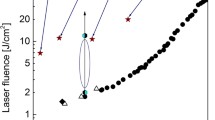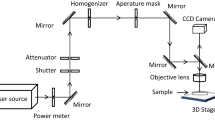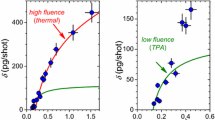Abstract.
Photon energy can be deposited efficiently into an exceedingly small volume by using a laser tuned to a vibrational resonance of the material. Both calcite and silica have absorption depths of a few tenths micron at the asymmetric carbonate stretch (7.1 μm) and the Si-O stretch (9.6 μm), respectively. With the pulse energy available from a tunable mid-infrared free-electron laser, the small absorption volume is rapidly superheated. The result is a very clean ablation crater with little or no evidence of melted material or other debris at the rim or outside of the ablation crater. We propose that this clean, fracture-free, highly efficient ablation of dielectric materials is the result of the rapid heating of the absorption volume, in which the heat is confined by the low thermal conductivity of the material, to a critical temperature Tc where explosive homogenous nucleation occurs.
Similar content being viewed by others
Author information
Authors and Affiliations
Additional information
Received: 26 November 1999 / Accepted: 28 March 2000 / Published online: 11 May 2000
Rights and permissions
About this article
Cite this article
Ermer, D., Papantonakis, M., Baltz-Knorr, M. et al. Ablation of dielectric materials during laser irradiation involving strong vibrational coupling . Appl Phys A 70, 633–635 (2000). https://doi.org/10.1007/PL00021072
Issue Date:
DOI: https://doi.org/10.1007/PL00021072




